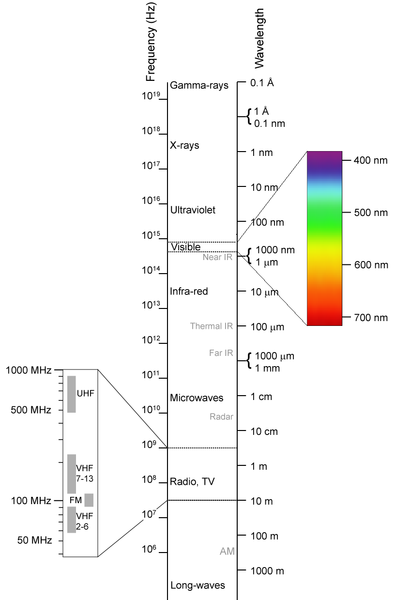Editor: Tanmoy Laskar

The Electromagnetic Spectrum (source: Wikimedia Commons)
Astronomy is arguably one of the oldest observational sciences, from the ancient Greeks and Egyptians, to the Babylonians and the Chinese, all of whom relied on their naked eyes for the study of the heavens. Since the invention of the first optical telescope during Galileo’s time in the early 1600’s, observational astronomy has come a long way, through the exciting years of the first radio telescopes in the 1930s, the first rocket-borne UV, X-ray and γ-ray observations in the 1960s and infra-red astronomy coming into its own in the 1980s.
Each time a new window in the electromagnetic spectrum has been opened up to astronomy in the last century, previously-unimagined wonders have been discovered. Telescopes have got bigger and better over the years, but the basic principles of many of them are decided by fundamental physics – and remain the same. In this glossary, we take each waveband of the electromagnetic spectrum in turn, from the radio through γ rays and address the following questions
- What astrophysical systems shine with this radiation?
(i.e. the Astronomy) - Which radiative processes does this radiation trace?
(i.e. the Physics) - How is it observed, and what are some of the world’s facilities dedicated to this waveband?
Radio
Radio waves penetrate through clouds, which makes them an ideal tool for astronomers living in wet countries. Earth’s ionosphere keeps the lowest frequencies (below the plasma frequency) from propagating through – the same mechanism makes skywave propagation of AM radio, and much of amateur (HAM) radio operation possible.
The following bands are discussed in the linked astrobite:
Microwave
Sub-millimeter [empty]
Infrared [empty]
Optical (Visible Light) [empty]
Ultraviolet [empty]
X-rays [empty]
ɣ rays
Cosmic Rays
Neutrinos
Gravitational Waves
